
The Cierva C.30 is an autogyro designed by Juan de la Cierva and built under licence from the Cierva Autogiro Company by A V Roe & Co Ltd (Avro), Lioré-et-Olivier and Focke-Wulf.
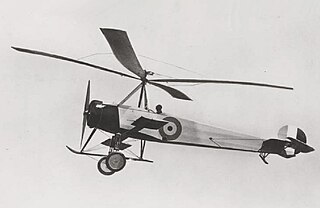
The Cierva C.6 was the sixth autogyro designed by engineer Juan de la Cierva, and the first one to travel a "major" distance. Cierva, the engineer responsible for the invention of the autogyro, had spent all his funds on the research and creation of his first five prototypes. Therefore, in 1923, he turned to the Cuatro Vientos Aerodynamics Laboratory chief, Commander Emilio Herrera, who succeeded in persuading General Francisco Echagüe, the director of the Military Aviation Aeronautics Department, to take over the second stage in the research and development of Cierva's autogyros.

The Pitcairn OP-1 was the first rotary-wing aircraft to be seriously evaluated by any of the world's major air forces. The machine was not a helicopter, nor an airplane, but an autogyro. Pitcairn's model was never put into production for any military.
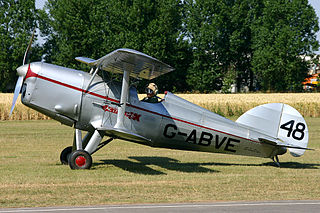
The Arrow Active is a British aerobatic aircraft built in the 1930s.

The Cierva C.8 was an experimental autogyro built by Juan de la Cierva in England in 1926 in association with Avro. Like Cierva's earlier autogyros, the C.8s were based on existing fixed-wing aircraft fuselages – in this case, the Avro 552.
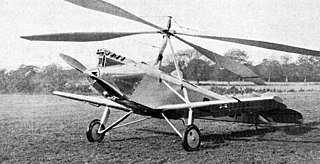
The Cierva C.17 was a British experimental autogyro built by Cierva Autogiro Company in England in 1928, in association with Avro. It was an attempt to build upon the successful Cierva C.8 design using the smaller, more streamlined fuselage of an Avro Avian IIIA as a starting point. The type was found to be underpowered, and when the first attempt at fitting a more powerful engine still did not result in acceptable performance, the design was abandoned.

The Cierva C.19 was a 1930s British two-seat autogyro, designed by Spanish engineer Juan de la Cierva. It was built by Avro as the Avro Type 620. It proved to be the most successful and widely produced of the early de la Cierva designs.

The Reid Rambler, later known under the Curtiss-Reid brand after Reid was purchased by Curtiss, was a biplane trainer/sport aircraft built in Canada in the early 1930s and used in small numbers as a trainer aircraft by the Royal Canadian Air Force.

The Pitcairn PA-34 and Pitcairn PA-33, given the United States Navy (USN) designation Pitcairn OP-2 and United States Army designation Pitcairn YG-2 respectively were reconnaissance autogyros designed and built in 1936 for evaluation.

The de Havilland T.K.1 was a 1930s British two-seat biplane and the first design built by students of the de Havilland Technical School.
The Cierva C.40 was a British autogyro designed by G.B.L. Ellis, Otto Reder, and Dr. J.A.J Bennett and was assembled by the British Aircraft Manufacturing Company at London Air Park, Hanworth.

The Little Wing Autogyro is a series of conventional one and two place autogyros with a tractor engine layout using modern engines and produced by Little Wing Autogyros, Inc. of Mayflower, Arkansas.
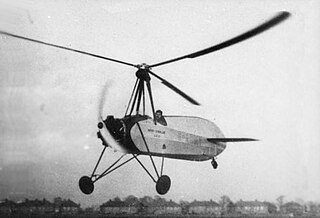
The Hafner A.R.III Gyroplane was a British 1930s experimental autogyro designed by Austrian Raoul Hafner, and built by the A.R.III Construction Company at Denham, Buckinghamshire.

The AutoGyro Calidus is a German autogyro, designed and produced by AutoGyro GmbH of Hildesheim. The aircraft is supplied as a complete ready-to-fly-aircraft.
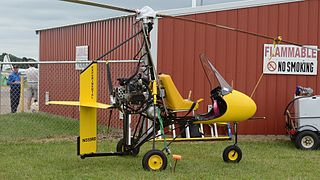
The Rotor Flight Dynamics Dominator is an American autogyro designed by Ernie Boyette of Rotor Flight Dynamics of Wimauma, Florida, and made available in the form of plans and kits for amateur construction.
The Cierva C.29 was a five-seat British cabin autogyro built in 1934 as a joint venture between Westland Aircraft and Cierva. The rotor system and rotors were designed by Cierva and the fuselage by Westland. It was powered by a 600 hp (447 kW) Armstrong Siddeley Panther II engine with a two-bladed tractor propeller; the engine also drove the three-bladed rotor via a clutched shaft. The C.29 suffered from ground resonance during ground running and was not flown. It was later acquired for evaluation by the Royal Aircraft Establishment but it was unable to cure the resonance problem and the autogyro was scrapped in 1939.
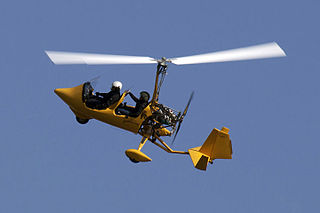
The ELA 07 is a series of Spanish autogyros, designed and produced by ELA Aviación of Córdoba, Andalusia. The aircraft are supplied complete and ready to fly.
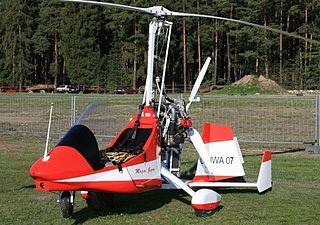
The Magni M-14 Scout is an Italian autogyro, designed and produced by Magni Gyro srl of Besnate. The aircraft is supplied as a complete ready-to-fly-aircraft.
The SkyCruiser Autogyro SkyCruiser is a series of Hungarian autogyros designed and produced by SkyCruiser Autogyro KFT of Inárcs. It was publicly introduced at the AERO Friedrichshafen airshow in 2014. The aircraft is supplied complete and ready-to-fly.
The Titanium Explorer is an Australian autogyro designed by Neil Sheather and Andrew Pepper and produced by Titanium Auto Gyro of Attunga, New South Wales. The aircraft is supplied complete and ready-to-fly, although development of a kit for amateur construction was underway in 2015.
















